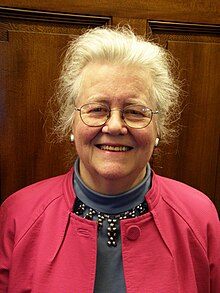"White Privilege: Unpacking the Invisible Knapsack" is a 1989 essay written by American feminist scholar and anti-racist activist Peggy McIntosh.[1][2][3] It covers 50 examples, or hidden benefits,[4] from her perspective, of the privilege white people experience in everyday life.[5]

Themes
editMcIntosh outlines "invisible systems" at work,[1] as well as the main theme of an "invisible package of unearned assets", examined in the form of a metaphorical knapsack. The essay features 50 of her insights into experiential white privilege, listed numerically. These have been described as "small benefits that white Americans enjoy every day".[6]
Reception
editThe Atlantic has written that the intention behind the essay was to inspire "self-reflection, enhancing their capacity for empathy and compassion".[7] It has been described by Vice as one of the most authoritative texts on the subject of white privilege,[8] and The Harvard Gazette have called it a "groundbreaking article" and the most important of McIntosh's academic career.[9] It has been cited as responsible for the mainstreaming of discussion of white privilege,[10] becoming a "staple of discussions about bias" in society.[11] In 2018, artwork and studies inspired by the essay had become popular in social justice sections of social media, such as Tumblr.[12]
Influence on education
editThe essay has become one of the key teaching resources in the study of white privilege in the United States and Canada.[13][8] In 2016, some New York City public schools assigned the essay to high school students.[4] In 2017, a high school in Caledon, Ontario incorporated the essay in an 11th grade anthropology class.[13] Conor Friedersdorf recommended including the essay in college curricula.[14]
McIntosh's essay inspired "Privilege Walks", workshops, and other activities to help students identify their privileges.[15]
Privilege Walks
editThe origin of Privilege Walks (initially known as "Power Shuffles"[16]) is often attributed to McIntosh in the 1990s. Although her essay inspired them, in 2021, McIntosh denied any association with such practices and emphatically discouraged engaging in them:
I did not invent the exercises... and in fact I urge people not to undertake such exercises. They are too simple for complex experiences relating to power and privilege. I don’t know where they originated. They seem to answer a craving for instant one-size-fits-all awakenings. I think they are counterproductive.[16]
References
edit- ^ a b "Beto O'Rourke and the proliferation of white privilege accusations". BBC. March 27, 2019.
- ^ Spencer, Kyle (February 20, 2015). "At New York Private Schools, Challenging White Privilege From the Inside". New York Times.
- ^ Pearson, Luke; Verass, Sophie (January 7, 2019). "10 things you should know about white privilege". sbs.com.au.
- ^ a b Edelman, Susan (July 23, 2016). "City's public schools join fight against 'white power'". New York Post.
- ^ Love, Catherine (March 13, 2016). "Deborah Pearson: 'It's about using my privilege to amplify other voices'". The Guardian.
- ^ Desmond-Harris, Jenée (July 24, 2015). "White people have a race — but everyone flips out when we talk about it". Vox Media.
- ^ Friedersdorf, Conor (September 17, 2019). "The Corruption of 'Privilege'". The Atlantic.
- ^ a b "White People Talk About Their White Privilege". Vice Media. September 17, 2019.
- ^ Koch, Katie (December 19, 2012). "Using privilege helpfully". The Harvard Gazette.
- ^ Leonard, David (September 2, 2016). "The NFL is 67% black. Diversity hasn't helped white players and coaches understand racism". Vox Media.
- ^ "Educator: Time to unpack your invisible knapsack of privileges". The Seattle Times. April 13, 2017.
- ^ Sarappo, Emma (December 13, 2018). "How Tumblr Taught Social Justice to a Generation of Teenagers". Pacific Standard.
- ^ a b Bascaramurty, Dakshana (October 16, 2017). "How Legos helped build a classroom lesson on white privilege". The Globe and Mail.
- ^ "What Does 'Cultural Appropriation' Actually Mean?". The Atlantic. April 3, 2017.
- ^ Milstein, Tema; Pileggi, Mairi; Morgan, Eric (2017). Environmental Communication Pedagogy and Practice. Routledge. p. 212. ISBN 978-1138673090.
This exercise, inspired by Peggy McIntosh's (1989) "White privilege: Unpacking the invisible knapsack," helps learners locate themselves within a spectrum of environmental privilege, centering the roles of socio-economic class, race, gender, sexuality, colonialism, and global disparities in environmental experience.
- ^ a b Parenti, Christian (November 18, 2021). "The First Privilege Walk". Nonsite.com. Retrieved February 4, 2022.
External links
edit- Peggy McIntosh (1989). "White Privilege: Unpacking the Invisible Knapsack". The National SEED Project - Wellesley Centers for Women. Wellesley College. Retrieved 19 February 2022.
- "Peggy McIntosh's White Privilege Papers". National SEED Project. Retrieved 30 January 2024.